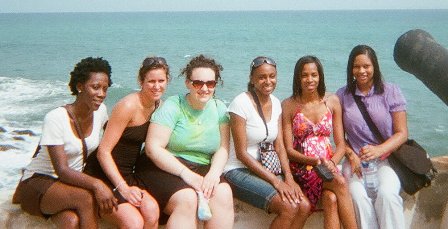SU Students Study History, Tradition in Ghana
 |
|
From left: Mariama Saffa, Megan Echoff, Erika Dula, Tisheika Warner, Tiffany Polk and Brittney Jones. |
SALISBURY, MD---African tribal chiefs, Swedish and British slave “castles” and kente cloth weaving are things many students studying African history may read about.
For two Salisbury University English faculty members and seven students, however, these people, sites and rituals are things they got to experience during a recent study abroad trip to Ghana.
Dr. Kelli Randall and Tonya Price recently led students from Randall’s Literature of the African Diaspora class to the West African country to witness in person much of what they had read about in the classroom. Students on the study abroad trip included Erika Dula of New Market, MD; Megan Echoff of Narvon, PA; Brittney Jones and Tisheika Warner of Salisbury; Tiffany Polk of Hebron, MD; Mariama Saffa of Laurel, MD; and Jessica Winslow of Pocomoke City, MD.
During their visit, students stayed at the University of Ghana’s Legon campus, where they heard presentations from Legon faculty on the archaeology of slavery, slave lifeways and languages of Ghana. They also visited other educational institutions, including the Kwame Nkrumah University of Science and Technology and the Centre for National Culture.
Students and faculty also toured historical and cultural sites including the Assin Manso Slave Bath site, where Africans captured in Ghana took their last baths before boarding slave ships; the Asante King’s Palace Museum; the mausoleum of inaugural Ghanaian President Kwame Nkrumah; the polo grounds in the capital city of Accra; the modern-day village of Ntonso; and the Accra Arts and Crafts Center.
Other notable sites included the Asante Craft Centres, where students learned about wood carving, adinkra cloth making and printing, and kente weaving; and the Cape Coast and Elmina slave castles, where Christians worshipped on the upper levels while an estimated 60 million slaves were held captive in the dungeons below over the course of three centuries. President Barack Obama visited Elmina last July, unveiling a plaque dedicated to the million of slaves who died in the castles.
One of the highlights of the SU trip came following a visit to the reconstructed Frederiksgave plantation in the village of Sesemi, which represents Dutch experiments with domestic slavery in Africa in the 1870s. After the tour, the group was given the chance to meet the Sesemi tribal chief, Nii Anom Momli, who welcomed the students and faculty with the phrase "Akwaaba,” translated as “You are welcome.”
Of all the sites the class saw, most agree that the most astonishing one was that of poverty throughout the country. Many of the villagers students and faculty met lived in huts, mud houses or shacks without electricity or running water. However, the SU guests were able to see beauty in the communities’ simplicity and the happiness of their people.
“Underneath the impoverished conditions, there underlies an inherent beauty in the landscape of Ghana and its people’s warmth,” said Price.
For Randall, the experience was life-changing: “We here in American have so much to be grateful for. We think that we have problems and issues here, but seeing the plight of poverty-stricken Ghanaian people is a very humbling and convicting experience. Ghana has forever reshaped my outlook on life.”
For more information call 410-543-6030 or visit the SU Web site at www.salisbury.edu.
